Preiser W., Smith K.H. Universal Design Handbook
Подождите немного. Документ загружается.

This page intentionally left blank

CHAPTER 45
MY STORY
Rosemarie Rossetti
This personal story is told from the author, of how her home intensified her disability after a spinal
cord injury and what steps she took to learn how to design and build a universal design home, result-
ing in the Universal Design Living Laboratory.
45.1 INTRODUCTION
Sometimes life suddenly changes direction.
On June 13, 1998, our third wedding anniversary weekend, my husband, Mark Leder, and I went
for a bicycle ride on a wooded bike trail in Granville, Ohio. After riding for about 10 minutes, Mark
thought he heard a gunshot and slowed down to investigate. As he scanned the scene he saw a large
tree falling. He shouted, “Stop!” But the warning was too late. Instantly, I was crushed by a 7000-lb
tree and paralyzed from the waist down.
When we were first married, we started building our home. We asked our builder to put in a few
wider doors in the master bedroom and bathroom to accommodate wheelchairs, should our visiting
parents need them for mobility as they got older. We also had lever handles put on all the doors to
make them easier to open. We were thinking ahead to our future and selected a two-story floor plan
with the master bedroom suite on the first floor, to make the home more accessible. We expected to
live in our home indefinitely.
45.2 TRADITIONAL HOME DESIGN PROBLEMS
After six weeks in the hospital, I returned home seated in my wheelchair with a different worldview—
that of a person with a spinal cord injury. Our traditionally designed home had many problems, the
first of which were the steps at all four entrances.
The temporary ramp to the front door built by my husband, family, and neighbors was very steep.
The carpeting in my home was hard for me to roll on. Doors had to be removed so I could enter the
laundry room, toileting area, and shower. Privacy was lost! Cramped quarters in the laundry room made
me angry as I banged up the washer, dryer, and walls with my wheelchair. I used a top-loading washer
and had to use a reacher to pull out every single item. It takes forever to do a load of laundry.
Mark and I operated our separate businesses out of our home. Half of our house was “off limits” to
me due to the steps to the basement and steps to the second floor, which contained his office and our
guest bedroom and bathroom. Accessibility was a problem for me because as I sat in my wheelchair,
I was 4 ft 2 in. tall. Mark in contrast was 6 ft 4 in. Due to my limited reach, my independence was
compromised.
45.3

45.4 EPILOGUE
Our dream home had become more of a nightmare, with stairs that I couldn’t climb; cabinets,
pantry shelves, microwave oven, freezer, electrical outlets, and light switches beyond reach; no
grab bars on the walls; bathtubs that I couldn’t enter without assistance; no knee space under the
cooktop or sinks; countertops too high for food preparation; thick padded carpet; and an oven with
a bottom-hinged door. Since my injury, we have been planning to build a home that would better
accommodate both of us.
The first I heard about universal design (UD) was through a magazine article. I saw pictures of a
woman in a wheelchair in her UD kitchen and realized that if I could build a new house, someday I,
too, could have a kitchen like hers. A UD kitchen would make cooking so much easier for me! Since
cooking was a passion of mine, I was excited about the possibilities. Encouraged by the concept, I
devoted my time to research, including trips to the library, Internet searches, speaking with others
who use wheelchairs, and a visit with our city’s independent living center (ILC) director. I got floor
plan books from the library and from builders. We visited homes built and occupied by wheelchair
users and took extensive notes on what features limited accessibility for the owners and which fea-
tures worked well. After months of information collection, Mark began to sketch out a floor plan
for our new house.
45.3 ARCHITECT SELECTION AND DESIGN TEAM APPROACH
The process began with choosing a home site location. In the summer of 2004, we drove around
the section of town where we wanted to live and found a new subdivision. Two builders had several
lots available. Each builder had only one ranch-style floor plan to offer. Neither builder discussed
UD features to offer us. We went through many model homes and became discouraged. Mark had
to push me up the steps in my wheelchair to each model home. Our analysis of space within the
home revealed that these floor plans did not meet our needs. When we asked if these builders had
UD options that they could include, they said they had built homes for people with disabilities in the
past and could modify the plans to accommodate me.
Based on referrals, we selected our builder. He told us we could modify his existing floor plan
by erasing all interior walls and redrawing a new floor plan within the original house footprint. So
we put a deposit on a lot. Mark and I quickly became overwhelmed with the design process, so
began our search for an architect. We contacted the ILC and Bureau of Vocational Rehabilitation for
architect recommendations.
Our builder recommended an architect who, when asked, “How would you approach the design
of the kitchen for our universal design home?” answered, “I would let the cabinet company lay out
the floor plan.” He clearly had no experience with UD and simply wanted to delegate the whole task.
When working with a builder or the builder’s architect, one should not assume that either of them is
familiar or proficient in integrating UD features in a house plan.
A colleague recommended architect Patrick Manley (www.manleyarchitects.us). Manley came
to our home with his construction manager and feng shui consultant, Cathy Van Volkenburg. He
brought us his reference list and described previous projects where he worked on ADA-compliant
housing projects, as well as residential universal design.
We hired Manley in September 2004. Over the next few months, we held meetings with Manley
in our home as well as in his office (see Fig. 45.1), and we realized we were spinning our wheels
trying to “shoehorn” our space needs into the builder’s existing footprint. The only logical solution
would be to create a unique floor plan from scratch.
We monitored the square footage to keep the costs lower. We avoided space wasters such as a too
large foyer. The house was designed from the inside out. First we positioned rooms in relation to one
another to best accommodate our need for sound and sight privacy, as well as looked at how the space
was to be used. Then we sized each room based on the measurements of our existing rooms and fur-
niture. Existing and new furniture was placed on the plan, and pathways of travel and circulation pat-
terns were determined, allowing space for my wheelchair. To comply with UD, doors were designed
to be 36 in. and hallways 48 in. wide. Finally, the exterior shell of the home was detailed.
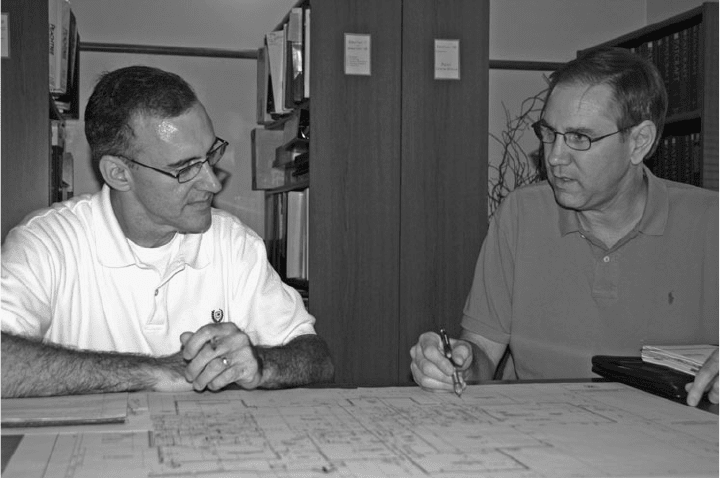
MY STORY 45.5
We also looked at how space could be used for multiple functions as well as the point where items
or equipment would be used. We considered point of use when locating appliances. This point of
use mind-set helped us to determine our need for space. We found that the laundry area would better
serve us if it were incorporated in the master closet area (see Fig. 45.2), so we created a wardrobe
area. Manley also designed one of the hallways to serve double use, by utilizing one wall to serve as
our library (see Fig. 45.3). The kitchen center island serves as a workstation for multiple cooks and
also can be used as an informal dining area.
This ranch-style home is approximately 3500 ft
2
, containing two bedrooms and two home offices
on the first floor and a full basement. The home was designed to be easy to maintain with ample
space for working, entertaining, and housing extended-stay family or guests.
To give the kitchen and bathrooms expert consideration, in January 2005 we hired Mary Jo
Peterson, a kitchen and bath universal design specialist (www.mjpdesign.com). She worked closely
with Mark and me to accommodate our needs. She analyzed all our height and reach specifications
and carefully thought out the sequence of events that I go through to store, prepare, cook, serve
food, and clean the kitchen. She designed the kitchen (see Fig. 45.4), all bathrooms, and the master
closet (see Fig 45.2), and she helped in the selection of the fixtures and appliances. Her plans were
incorporated into Manley’s floor plan.
Anna Lyon, an interior designer and best friend (see Fig. 45.5), worked with us to design the floor
plan (www.annalyoninteriordesigns.com). She provided feedback that we shared with Peterson and
Manley in order to modify the plan. Lyon was particularly interested in the room size and layout
in relation to the circulation flow. She made suggestions on furniture placement and sketched in
furniture to scale. Lyon also accompanied Mark and me to showrooms to select bathroom fixtures,
cabinets, countertops, flooring, hardware, tile, and paint colors.
FIGURE 45.1 Architect Patrick Manley and the author’s husband, Mark Leder, review and evaluate the house plans
for the Universal Design Living Laboratory.
Long description: In this photo, architect Patrick Manley sits with the author’s husband, Mark Leder, to discuss the
house plans for the Universal Design Living Laboratory. Leder initiated the design process by sketching out a block
layout of the rooms. Manley created the blueprints and details for the house plans. Manley started with the interior floor
plan design. Working from the “inside out,” he later created the exterior elevations of the house.
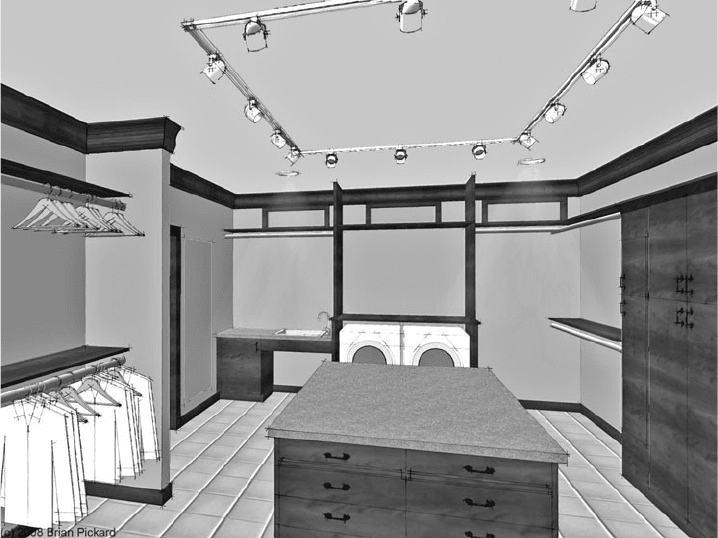
45.6 EPILOGUE
In January 2005, Mark and I met with our mastermind group for the first time. This is a group
of eight other professional speakers, trainers, writers, and consultants who met to help suggest ways
to develop our businesses. They suggested that our home be a national demonstration home and
be open to the public and the media. They also advised us to seek corporate contributors and other
partners to help us with the funding and educational mission of our project.
Mark and I began contacting international, national, and local corporate contributors. Thanks to
the efforts of S. Robert August (www.srobertaugust.com) whom we hired in October 2005 as our
Executive Business Development Strategist, contributors pledged their support for the project.
The house, named the Universal Design Living Laboratory (www.UDLL.com), will serve as
a national model prototype. The mission is to bring about awareness of the quality of indoor and
outdoor lifestyle through universal design, green building, safety, and healthy home construction
practices to the public, as well as the construction and design industries. The UDLL will serve as
a resource for others to learn from—today and tomorrow. The landscape will incorporate UD fun-
damentals, including raised landscape beds and large pots of plants placed on the patio that are tall
enough for a person to access from a wheelchair.
The lighting design process began with seven graduate students and faculty members, Patricia
Rizzo and Russ Leslie at the Rensselaer Polytechnic Institute (www.lrc.rpi.edu). In January 2006,
the class interviewed Mark and me by telephone, and I met with the students (see Fig. 45.6) to teach
them about universal design and share our vision of the style of lighting fixtures as well as the lighting
effect we were trying to achieve. We also reminded the students that this home would be certified
FIGURE 45.2 This is the architect’s rendering of the combination laundry room and master bedroom closet.
Long description: The elevation drawing shows the utility sink, washer, dryer, and ironing center. There is knee space under
the sink so a person seated in a wheelchair has ample room. Some of the clothing rods are installed in two tiers. Special pull-
down hardware will be installed on the upper clothing rods in order to access them from a seated position. This room is adjacent
to the master bathroom. Tall windows provide natural light and privacy. The island also provides a space to fold clothes as well
as pack and unpack luggage which will be stored in this room. Folded clothing will be stored in the center island.
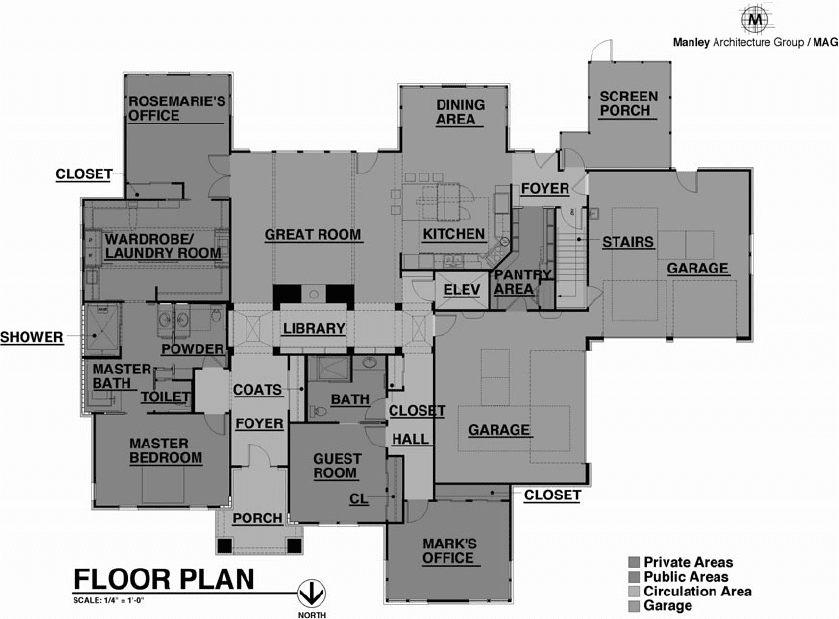
MY STORY 45.7
green through the U.S. Green Building Council in their LEED for Homes program, so all lighting
needed to be energy-efficient and incorporate LED and halogen light sources. The students presented
a house lighting design for us to share with Manley and Lyon.
In February 2006, the project stalled when the homeowner’s association where the home site
was located met with Mark and me. They asked us not to build in their neighborhood due to the
anticipated traffic from the tours and media, since this house would be open to the public. Mark and
I began searching for a new lot, not in a subdivision.
In December 2006, we purchased a 1.5-acre lot and asked Manley to redesign the house roof
line and entry to be more in line with the architectural Prairie style that Frank Lloyd Wright made
famous. Manley added a clerestory and portico to the house and created a dramatically different look
to our home (see Fig. 45.7). Due to the increased ceiling height in the great room and kitchen, as well
as the additional windows in the clerestory, we needed to revise the lighting design.
In May 2007, I got a call from our builder indicating that they were having financial problems
that led them out of business. Mark and I interviewed a dozen other builders and in September 2007
decided to be our own general contractors. To assist in this endeavor, we hired Bob White and Chris
Vandenoever to be our construction managers. Our design and building team was growing, and
we asked our new managers to review the plans and make suggestions for improvements to lower
the budget and facilitate the building process. Lighting designer Ardra Zinkon (www.tecinc1.com)
joined the team in February 2008 and met with Lyon to revise the lighting design.
FIGURE 45.3 The 3500 ft
2
floor plan for the Universal Design Living Laboratory.
Long description: The 3500 ft
2
floor plan of the Universal Design Living Laboratory shows the room layout for the public, private, and
circulation areas of the home, as well as the four-car garage. The home contains two bedrooms and two home offices on the main floor. The
master bath is adjoined to a laundry room that includes the master closet.
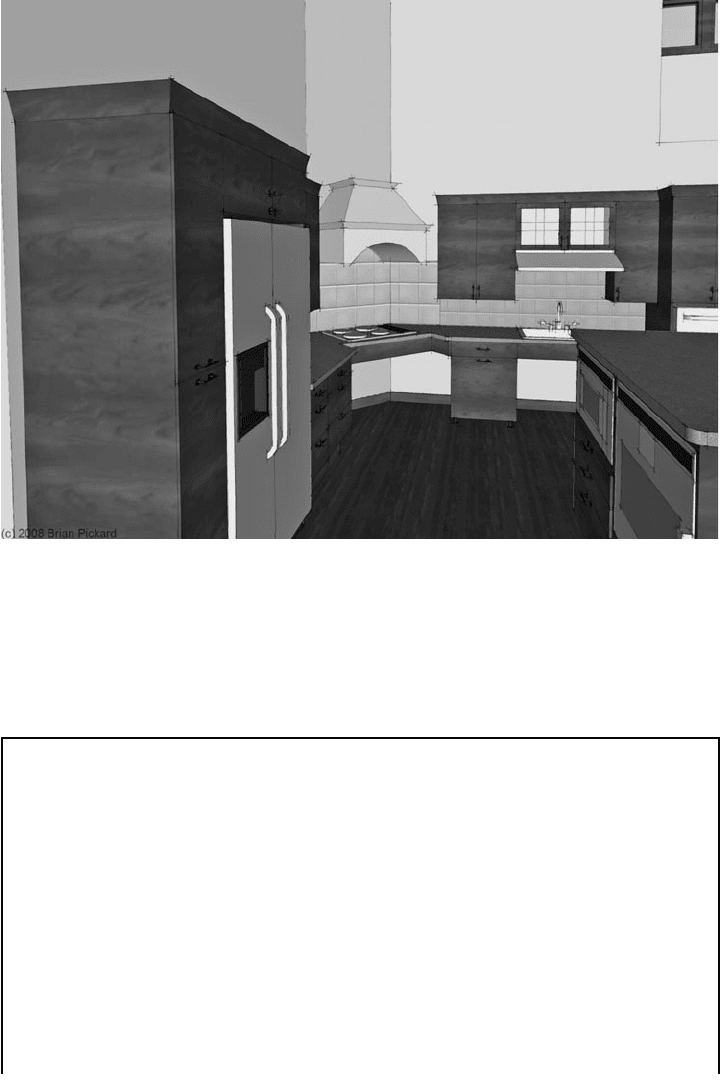
45.8 EPILOGUE
Box 45.1 Features Included in the UDLL
Front Entry
• Stepless entrance
• Level threshold no higher than 1/2 in.
• 42-in.-wide door with lever handles
• Porch shielded from the weather
• Package shelf or bench
Kitchen
• Suffi cient clear fl oor space for work/traffi c fl ow
• Hardwood fl ooring
• Flexible pantry storage
• Rollout carts for storage of cookware
• Single lever faucets, mounted on the side of a low-profi le sink
• Pot fi ller at cooktop
FIGURE 45.4 This is the architect’s rendering of the kitchen in the Universal Design Living Laboratory.
Long description: The kitchen elevation of the Universal Design Living Laboratory shows the side-by-side refrigerator,
cooktop, sink, as well as the microwave and oven in the center island. There is knee space under the cooktop and sink
so a person seated in a wheelchair has ample room. The wall cabinets are slightly lower than traditional cabinets, and
the countertops are 34 in. high. There will be a pot filler by the cooktop. The kitchen is under the clerestory area with
windows above.
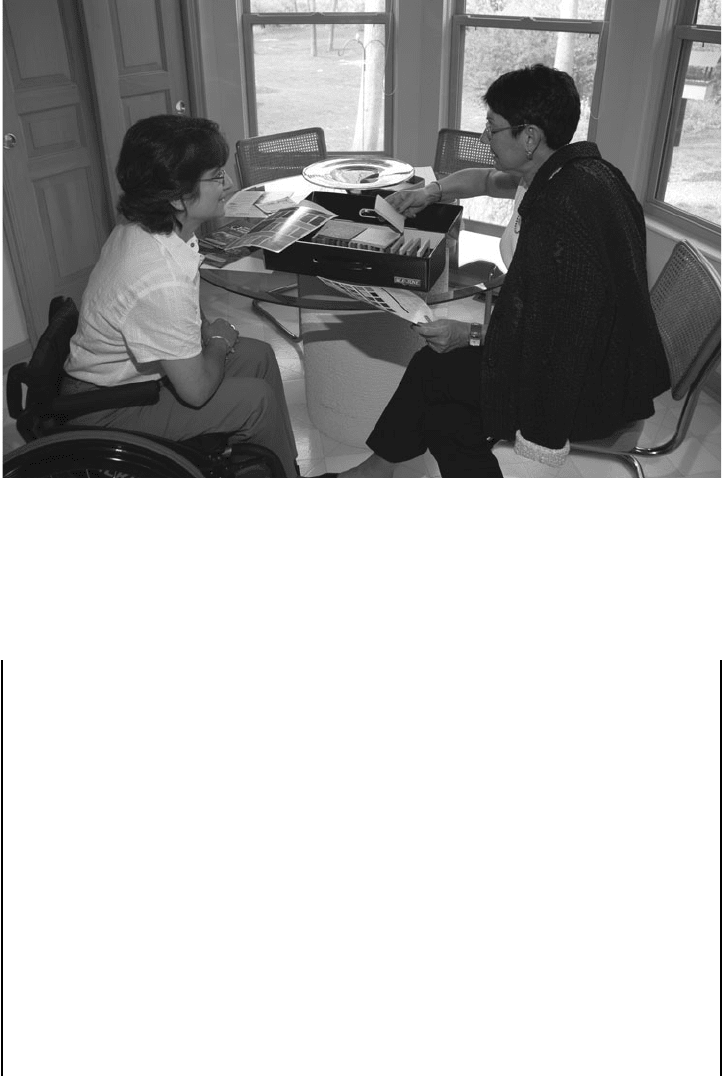
MY STORY 45.9
• Garbage disposal mounted in the rear of the sink
• C- or D-shaped handles on cabinets and drawers
• Countertops at a variety of common heights: 30, 34, 36, and 42 in.
• Rollout full-extension shelves and drawers in lower cabinets
• Pull-down articulated hardware to lower shelf contents stored in wall cabinets
• Toe kick area at the base of lower cabinets: 9 in. high by 6 in. deep
• Pantry cabinets with pullout shelving for most used items
• Side-by-side refrigerator/freezer with full-extension shelves
• Side-hinged doors on oven and microwave at counter height
• Dishwasher elevated 8 in. above the fl oor
• Front-mounted controls on all appliances with easy-to-read print
• Knee space under sink and cooktop
• 5-ft turning radius in working areas
• Electrical outlets 18 in. above the fl oor
• Light switches 48 in. above the fl oor
• Adjustable lighting controls with dimmer switches
Bathrooms
• 36-in.-wide swinging doors with lever handles and/or pocket doors
• 5-ft turning radius in key areas
FIGURE 45.5 Author, Rosemarie Rossetti, with Anna Lyon, interior designer.
Long description: At an early meeting in her current home, Rosemarie Rossetti sits at her kitchen table with interior
designer Anna Lyon to select countertop colors for the Universal Design Living Laboratory. Silestone countertops will be
in the kitchen and bathrooms. This quartz material solid surface will also be used on the roll-in shower walls. A leather-
look finish is being examined so that light does not glare off the countertops.
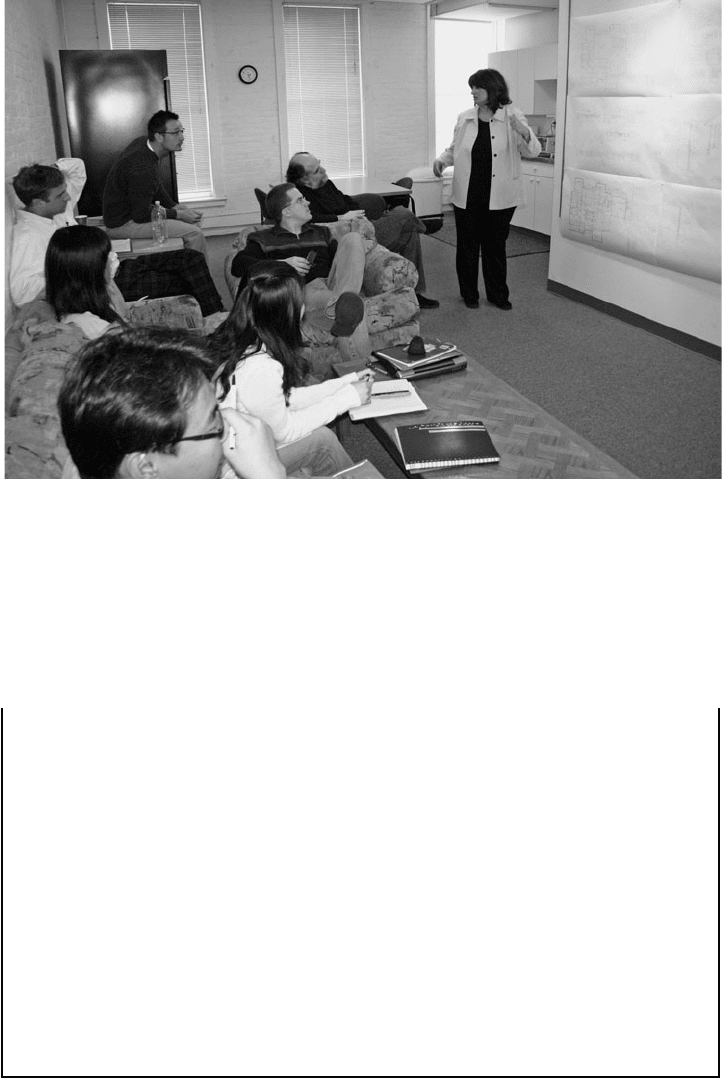
45.10 EPILOGUE
FIGURE 45.6 Design Program Manager Patricia Rizzo of the Rensselaer Polytechnic Institute with her graduate
students as they discuss the lighting design.
Long description: In January 2006, seven graduate students and Design Program Manager Patricia Rizzo of the
Rensselaer Polytechnic Institute discussed the lighting design for the Universal Design Living Laboratory. Rosemarie
Rossetti was present and taught the students about universal design in the home. The students were each assigned a room
to design and presented their lighting design to Rossetti and Leder at the end of their course.
• Multiple-height vanities with fl exible knee space under the sink
• Toe kick area at the base of lower cabinets: 9 in. high by 6 in. deep
• Grab bars in the toileting, shower, and tub areas
• Walls reinforced with ¾-in. plywood for grab bars
• Antiscald fi ttings on tub and shower
• Nonslip ceramic fl ooring
• Controls for windows, lighting, and fi xtures that are easy to operate
• Vanity mirror at height for a seated person
• Curbless shower and bench
• Towel bars at various heights
• Handheld shower spray on a sliding vertical bar, with 60-in.-long hose
• Water controls on shower and sink within arm reach while seated
• Tub deck with 15-in. extension
• Tub with nonslip bottom and built-in grab bars
• Comfort-height toilets 17 to 19 in. from the fl oor
• Increased lighting from varied sources with adjustable controls
• Electrical outlets and lighting controls within arm reach while seated
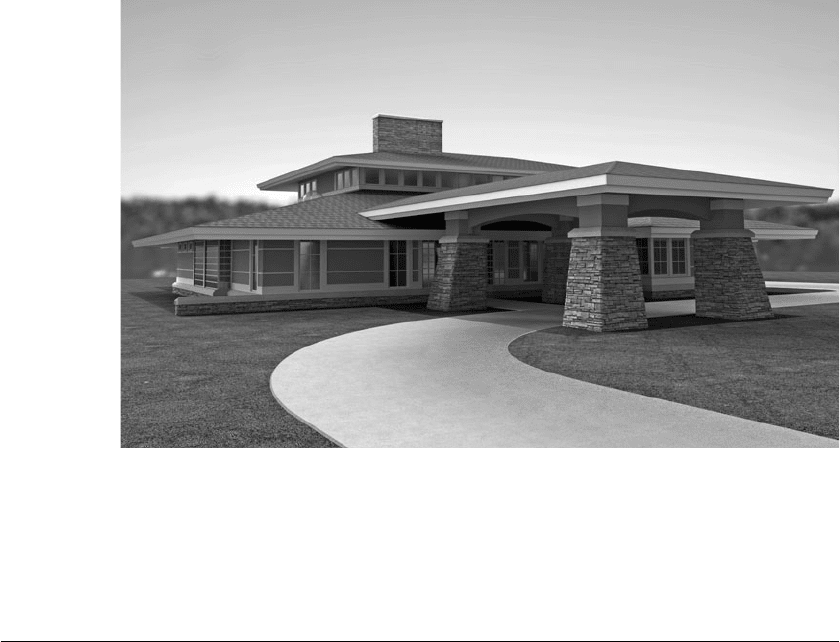
MY STORY 45.11
45.4 REFLECTIONS ON THE DESIGN PROCESS
By working with the above referenced team of professionals, we feel that our decisions on space
planning were carefully considered. The skills of all persons complemented one another. Each
brought her or his own area of expertise, experience, and wisdom. Many suggestions were presented
for consideration. Mark and I made the ultimate decisions. Since our project was a custom home, we
were able to create the space to be any size, and we selected products from around the world.
It was an interesting dialogue among our team members, and our periodic face-to-face meet-
ings always were productive. I took detailed notes of any changes that were needed in the plan
and summarized them for the team. Constant communication was a key to the coordination of
the design process, with e-mails, telephone calls, and electronic floor plans being exchanged on
a continuous basis.
The time spent in the design process will make the house more usable, accessible, and aestheti-
cally beautiful. Construction dollars will be saved due to our constant vigilance over the total square
footage and product selection. Better planning helps to keep construction costs within budget.
Changes made during the construction process, or worse yet, after the construction process, can be
terribly expensive! The architectural drawings will serve us and the contractors as we create this
one-of-a-kind prototype which is expected to be replicated in whole or part throughout the country.
Construction began in September 2009 and is expected to end in the summer of 2010. Net proceeds
from tours for the month the home is open to the public will benefit spinal cord injury research.
It is our intent that people will borrow a few good ideas from this house in order to create their
own homes that will be more accessible and usable. Homes that include UD features enable the
occupants to live with greater independence throughout their lifetimes.
FIGURE 45.7 This is the architect’s rendering of the front elevation of the Universal Design Living Laboratory.
Long description: Architect Patrick Manley refers to the “Prairie Style” when he describes the Universal Design Living
Laboratory. The Prairie Style home usually has low horizontal lines, a central chimney, an open floor plan, overhanging
eaves, a low-pitched roof, and clerestory windows. This ranch-style home was designed with 6 ft overhangs, determined
by solar angle calculations, and a clerestory to provide natural light to the interior and solar heat gain in the winter. The
portico at the front entry affords protection from weather in all seasons.
